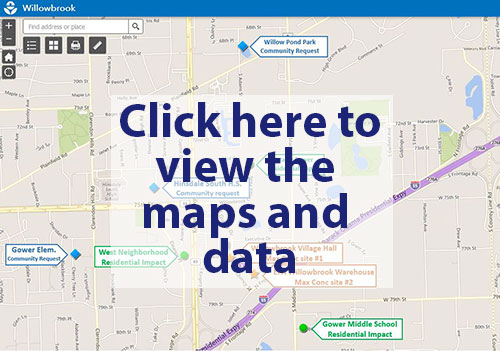Outdoor Air Monitoring in the Willowbrook Community
On this page:
- Where are the monitoring locations? How can I see the data?
- How did EPA choose the monitoring locations?
- Why aren't there more monitors?
- How long will EPA monitor?
- How long before EPA will tell us our risk?
- Technical Document: Quality Assurance Project Plan
- Potential issue regarding previous ethylene oxide monitoring results
U.S. EPA monitored outdoor air near the Sterigenics facility to better understand the levels of ethylene oxide (EtO) in the air. The first monitors began collecting air samples on Nov. 13, 2018. Read the Ethylene Oxide Ambient Sampling Plan for Sterigenics (Willowbrook, IL)
Where are the monitoring locations? How can I see the data?
- Two (2) locations were where we expected to see the highest concentrations of EtO
- Three (3) neighborhood locations were downwind of the facility to understand residential concentrations of EtO
- Three (3) locations were requested by the local communities
The Willowbrook map and data tables (located on a separate web page) provide monitoring data collected by U.S. EPA at the outdoor monitoring locations. U.S. EPA used these data to estimate the uncontrolled EtO emissions at the facility. Once the monitoring was completed, U.S. EPA conducted a refined risk assessment for the area near the Sterigenics, Willowbrook facility.

How did EPA choose the monitoring locations?
To find the best locations for placing the monitors, U.S. EPA first looked at the emission measurements collected at the Sterigenics facility (stack tests) in September 2018. We then conducted a technical assessment, including consideration of local wind patterns to see where the emissions might drift in the air during the winter season. In addition, we also consulted with the local community to get their input on monitoring locations. Based on this information, U.S. EPA selected eight locations provided the best picture of EtO concentrations in the outdoor air in the communities around the Sterigenics facility.
Why aren’t there more monitors?
In U.S. EPA’s experience, more monitors do not necessarily give us more useful information. When we site a monitor, we focus on the best locations based on meteorology and population to give us the best understanding of concentrations in the outdoor air.
How long did EPA monitor?
U.S. EPA collected air samples for 4-1/2 months, beginning in November 2018. U.S. EPA ended air quality monitoring in Willowbrook, Illinois, at the end of March 2019.
How long before EPA will tell us our risk?
Conducting an analysis of potential health risks takes time; it is a scientific process that will take several months. Estimating risk is a two-step process.
- Step one: Understanding how much EtO people are breathing. We start by collecting emissions data from the facility. There are two types of data: the controlled emissions (stack) measurements taken at Sterigenics in September along with estimates of the uncontrolled EtO emissions at the facility. This will take several months. We then take the emissions data and enter it into a computer model to calculate the long-term expected concentrations of EtO in the community.
- Step two: Estimating risk. U.S. EPA combines the modeled concentrations with information on the toxicity of EtO to estimate risks. This risk assessment will provide an estimate of an individual's chance of contracting cancer over the course of a lifetime (assumed to be 70 years) if they are continuously exposed to the expected EtO concentrations in the community.
U.S. EPA shared the risk assessment in spring of 2019.
Quality Assurance Project Plan
Read U.S. EPA's Quality Assurance Project Plan for Field Sampling Plan for Ambient Air Ethylene Oxide Monitoring near Sterigenics Facility, Willowbrook, IL
Potential Issue Regarding Previous Ethylene Oxide Monitoring Results
U.S. EPA discovered an issue with the way EtO has been measured. As a result of the issue, monitors may have reported higher ambient levels of EtO than actually exist. More specifically, the chemical Trans-2-butene can be incorrectly identified as EtO when air quality samples are being analyzed in a laboratory. Trans-2-butene can be released from petrochemical industrial processes and the burning of fossil fuels. U.S. EPA discovered the issue as part of its work to improve the analysis method for EtO.
What this Means
This discovery means that the results of air quality monitoring conducted prior to October 2018 may have shown higher concentrations of EtO than were actually in the air. This includes air quality monitoring that U.S. EPA’s Region 5 conducted in mid-May 2018 in Willowbrook, Illinois. U.S. EPA cannot fully evaluate the difference between reported and actual EtO concentrations, as the samples of air collected in mid-May are no longer available for analysis. U.S. EPA has made a change to its analytical method to prevent this issue in the analysis of future air quality samples – including those from monitoring started in November 2018 in the Willowbrook area. U.S. EPA is making the technical information about this change available for other laboratories.
Does the monitoring issue change EPA’s conclusions in the National Air Toxics Assessment (NATA)?
No. U.S. EPA would have been concerned about EtO in Willowbrook, even without air quality monitoring. U.S. EPA’s NATA identified census tracts in the Willowbrook area as a potentially higher risk community. NATA is based on air quality modeling: it does not rely on any air monitoring data.
In addition, in the health consultation conducted for U.S. EPA Region 5, ATSDR relied on both the Region’s modeled estimates of EtO in the outdoor air in the area near the Sterigenics facility as well as the results of the monitoring the Region conducted in mid-May.
